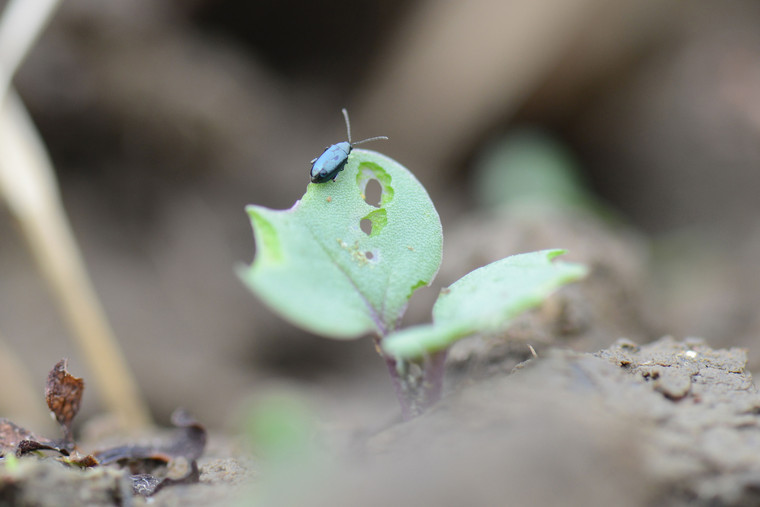Oilseed rape growers should look to control cabbage stem flea beetle from first emergence to give greatest effects in reducing damage, to help get crops quickly established.
Trials at the Syngenta OSR Innovation Centre, in Norfolk, have shown a 50% reduction in CSFB damage from a single application of Hallmark Zeon at first emergence. A two-spray programme, with a second application at the three-leaf stage, reduced overall damage by 62%, reported the site’s manager, Dr Max Newbert.
Monitoring of CSFB activity on the site highlighted first insect invasion occurred simultaneously with full crop emergence around 25 August, 14 days after drilling. The peak of pest invasion took off in the second week of September.
“Previously it has been considered that CSFB feed on the crop for a period, before starting to lay eggs in the soil. This work, studying adult feeding damage and subsequent larvae populations, indicates beetles migrating into the emerging crop may be ready to start laying almost immediately.
“That makes the early control timing a greater priority,” he advised.
Work that included trials with various integrated CSFB control techniques, revealed the outstanding result was the combination of buckwheat and berseem clover companion cropping, in combination with the two-spray Hallmark Zeon programme – achieving over 70% overall reduction in damage.
Whilst CSFB studies had indicated levels of some resistance to pyrethroid insecticides had increased in past seasons, reaching 69% in the previous season of 2020, the field trials had shown good control could still be achieved with appropriate timing and application techniques, suggested Dr Newbert.
“However, it does highlight the importance of using all available effective integrated control techniques to minimise the selection pressure of resistant variants and maintain the efficacy of future treatments.”
Companion cropping
“With companion cropping drilled the day after oilseed rape, there was still some negative effect from CSFB damage on the crop that was slower to establish because of competition,” he said. “However, in field-scale trials where the companion crop was broadcast on 10 days before the OSR it did have a positive benefit in protecting the crop from CSFB invasion.”
Dr Newbert warned slower growing varieties are likely to require greater protection, compared to more vigorous plants, such as hybrid varieties. Establishment techniques designed to conserve soil moisture and ensure consistent drilling depth have been demonstrated to significantly enhance crop growth and reduce impacts of CSFB damage.
The trials have shown using a physical cover to mask OSR from the beetle – such as straw mulch or top dressing with farmyard manure – can hold back crop establishment that runs the risk of increasing damage from CSFB. Furthermore, the work suggested the cover could interfere with insecticide application and reduce its level of adult beetle damage control.
“We did see that the Hallmark Zeon treatment programmes in all the IPM options reduced the level of larvae in the crop by 30% to 40% in spring,” he reported. “Even where reduction in adult feeding damage was limited, we still saw the reduction in larvae numbers.”
The companion cropping did also give a useful reduction in larvae numbers as a beneficial tool. Furthermore, when the selected mix was killed off by frosts over the winter, the buckwheat stems still acted as an effective deterrent from pigeon invasion in any crop gaps.
Rape winter stem weevil
Oilseed rape growers and agronomists have reported more sightings and issues with rape winter stem weevil in recent seasons, according to Dr Max Newbert. What had typically been seen as a pest of northern England and Scotland, had now been causing greater problems in eastern and southern England.
He pointed out that the weevil pest tended to invade crops from the end of September, through October. The adult requires four weeks of feeding on the plant before laying eggs directly on the leaf petiole.
“When larvae hatch, they bore straight into the leaf and head to the stem and crown of the plant, resulting in severe damage,” he warned. “That makes it crucial to control the adult weevil in its feeding phase, before the eggs are laid.”
Where Hallmark Zeon is used to target CSFB larvae at the September to October timing, it will coincide with weevil infestation into the crop. The good persistence of Hallmark Zeon will help to protect the crop through the key weevil migration timing, he added.




